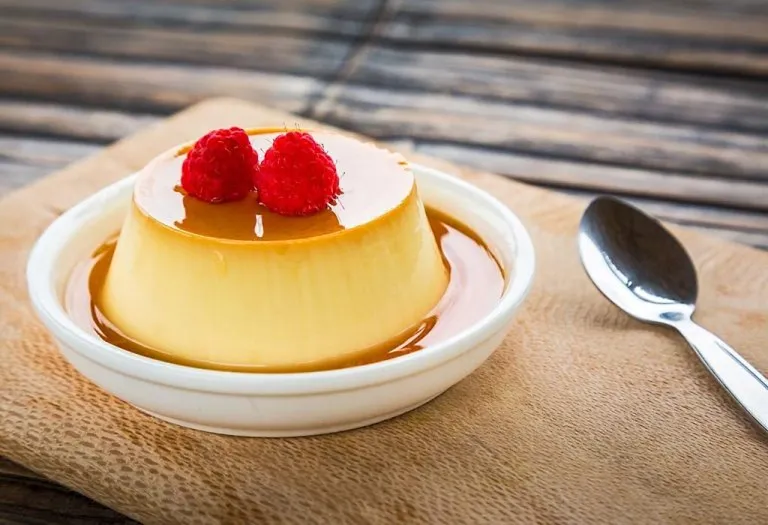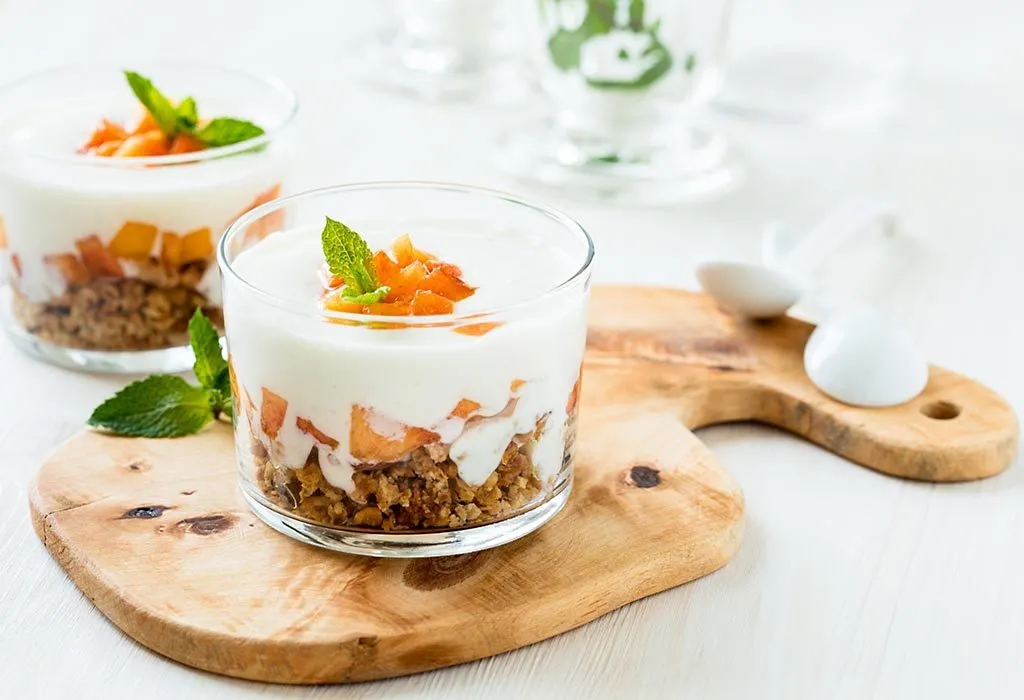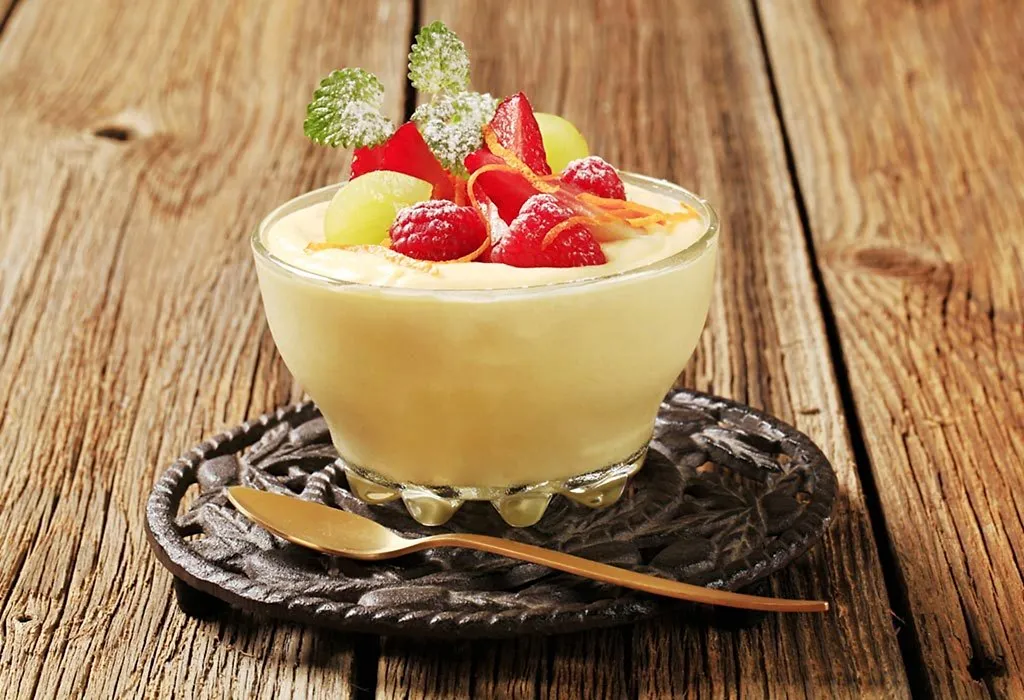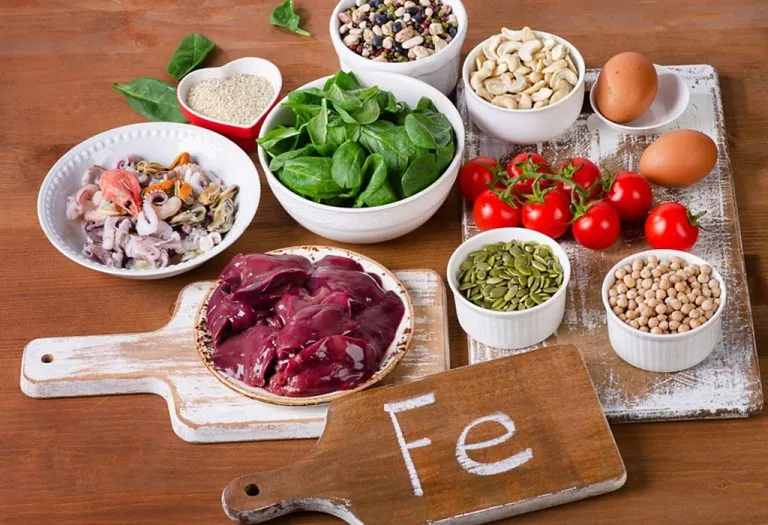Custard for Babies – Benefits, Side-effects and Recipes

Custard is definitely a lovely dessert to complete a meal, especially for older babies who can comfortably eat and digest solid foods. Soft in texture and thick in consistency, the dish is easy for kids to gum up and swallow, making it an ideal choice for a gentle introduction to desserts. Custard for babies can be a great way to offer a new taste and texture, but it’s important to choose recipes that are suitable for their age and nutritional needs. If feeding custard to your little one has been on your mind lately, ensure that you start with a small portion of an age-appropriate custard recipe and increase the quantity slowly.
Can You Give Custard to Your Infant?
Until your baby is an active toddler crawling at high speed, running or walking, it is not advisable to introduce custard to their diet. As your baby grows, he can easily digest all the foods you feed him. Then, you could go for different types of custard as dessert for your baby after each meal. Here are some custard recipes you can make for your little one.
Benefits of Feeding Custard for Your Baby
Custard can be a delicious and nutritious treat for your baby when introduced at the right time. Here are some benefits of feeding custard to your little one:
- Custard, often made with milk, is an excellent source of calcium, which is essential for the development of strong bones and teeth in babies.
- The carbohydrates in custard provide a quick source of energy, keeping your baby active and engaged.
- Custard’s smooth texture makes it easy for babies to digest, especially those transitioning to solid foods.
- Custard can be fortified with vitamins like vitamin D and B12, supporting overall growth and development.
- Introducing custard allows your baby to experience new flavours, encouraging a more diverse palate.
- The high water content in custard can help keep your baby hydrated, particularly during warm weather.
- For babies needing to gain weight, custard can be a calorie-dense addition to their diet.
- The cool, soft texture of custard can be soothing for babies experiencing discomfort from teething.
- You can easily add pureed fruits to custard, enhancing its nutritional value and taste.
- Custards made with whole milk or other dairy alternatives can promote healthy digestion due to their natural probiotic content.
- Its thick consistency allows babies to practice self-feeding, helping develop their motor skills.
Side-Effects of Custard on Babies
While custard can be a tasty treat for babies, it’s important to be aware of potential side effects that may arise from its consumption. Here are some possible side effects of feeding custard to your baby:
- Custard often contains dairy and eggs, which are common allergens that can cause reactions such as rashes, swelling, or digestive discomfort in some babies.
- Babies who are lactose intolerant may experience symptoms like bloating, gas, and diarrhoea after consuming custard made with dairy milk.
- Some custard recipes contain added sugars, which can contribute to tooth decay and unhealthy weight gain in babies.
- The rich and creamy nature of custard may be difficult for some babies to digest, leading to issues like constipation or upset stomach.
- Due to its pleasant taste and smooth texture, babies may consume more custard than necessary, leading to a reduced appetite for other essential foods.
- Relying too heavily on custard can result in a lack of balanced nutrition, as it may displace more nutrient-dense foods needed for proper growth and development.
- Improperly prepared or stored custard can harbour harmful bacteria, increasing the risk of foodborne illnesses in babies.
- Introducing custard too early in a baby’s diet may interfere with the recommended progression of solid foods and could lead to digestive issues.
Easy Custard Recipes for Babies
If you haven’t already fed your baby custard, you are probably wondering how you can feed it to your baby (1). Read on to find out some recipes for homemade custard for babies. These custard recipes for infants are not only popular among babies, but even grown-ups enjoy having them.
Please note that all the recipes given below are for one serving only. To make more servings, you may want to increase the quantity of each ingredient.
1. Oats Custard
Oats custard is a calcium-rich custard made with a combination of egg yolk, milk and oats. This recipe is wholesome and nourishing and is sure to become your baby’s favourite dish.
Preparation Time: 5 to 10 minutes
Cooking Time: 15 to 20 minutes
Appropriate for Age: 1 year and above
What You Will Need
- 2 tablespoon oats
- 1 cup milk
- One egg yolk
- 1 tablespoon brown sugar
- 1 teaspoon powdered dry fruit (optional)
How to Prepare
- Heat the milk, add brown sugar and mix it.
- Keep whisking the milk till it thickens and becomes cream-coloured. Whisking is important because milk gets burnt easily.
- Ensure there are no lumps in it.
- Toss the oats and powdered dry fruit.
- Mix well and cook the mixture until the oats are soft and mushy (5 minutes approximately).
- Switch off the gas once done.
- Bring the custard to room temperature before serving it to your baby.
2. Egg Custard
An easy and nutritious recipe, egg custard is a delicious dish for babies too, and we promise that you will never reach out for the ready-made custard once you have tasted a homemade version of it.
Preparation Time: 15 – 20 minutes
Cooking Time: 15 minutes
Appropriate for Age: 1 year and above
What You Will Need
- 1 egg yolk
- 1 tablespoon honey/castor sugar
- 1 teaspoon vanilla essence
- 1 cup of whole milk
How to Prepare
- Take a pan and whisk all the ingredients together.
- Keep the pan on low flame and keep stirring until the mixture thickens.
- When the custard coats the back of the ladle, remove it from the pan and set it aside for an hour or so.
- You may refrigerate the custard, but serve it to your baby at room temperature only.
3. Fruits With Custard
This recipe is yet another delicious yet healthy custard recipe for babies. You can choose to add any fruit you like in this recipe and feed it to your baby. You can feed most of the fruits to your baby if he does not like eating fruits.
Preparation Time: 10 to 15 minutes
Cooking Time: 10 minutes
Appropriate for Age: 1 year and above
What You Will Need
- 2 tablespoon mixed fresh fruits, finely chopped
- 1/4 cup, crushed and powdered makhana or whole wheat biscuits
- 1 teaspoon sugar
- 1/2 cup of whole milk
How to Prepare
- Boil milk in a pan.
- Add sugar to it and mix.
- Toss the makhana/ biscuits and keep stirring so that it doesn’t get burnt and has no lumps.
- Let this mixture cool completely.
- Add the chopped fruits and give it a good mix.
- Serve at room temperature.
4. Apple Custard
Apple custard is another calcium-rich custard with the goodness of apples, almonds, milk and egg yolk. It is a perfect dessert to meet the dietary requirements of your toddler.
Preparation Time: 15 minutes
Cooking Time: 15 to 20 minutes
Appropriate for Age: 1 year and above
What You Will Need
- 1 medium-sized apple
- ½ teaspoon cinnamon powder
- 1 tablespoon oats (optional)
- 5 cups of milk
- 1 egg yolk
- 2 tablespoon brown sugar
- 1 teaspoon powdered dry fruit(optional)
- 1 tablespoon powdered/chopped almonds
How to Prepare
- Wash the apple and peel the skin.
- Chop the peeled apple, steam it and make a puree.
- In a large bowl, whisk the egg yolk, brown sugar and milk.
- Ensure there are no lumps and whisk till you see small bubbles.
- Stirring continuously, heat the mixture on low flame for 2-3 minutes.
- When the mixture thickens and gets a creamy colour and texture, add the oats along with powdered almonds and powdered dry fruit.
- Mix well and cook until the oats are cooked completely(5 minutes approximately).
- Then, switch of the flame, add the apple puree and give it a good stir.
- Let the custard cool before serving.
5. Banana Custard
Banana is a good alternative for eggs. This recipe is a fantastic eggless dessert recipe made with banana, milk and custard powder – a great option for vegetarians.
Preparation Time: 15 minutes
Cooking Time: 20 to 25 minutes
Appropriate for Age: 1 year and above
What You Will Need
- 1 large banana
- 1.5 cups of milk
- 1 tablespoon custard powder
- 2 tablespoon jaggery/brown sugar/honey
- 1 tablespoon powdered or chopped dry fruit (optional)
How to Prepare
- Chop the bananas, keep some pieces aside for garnishing and grind the rest.
- Mix the custard powder in half a cup of milk and whisk it well to remove lumps.
- Heat the remaining milk in a pan on low flame and add the custard mix bit by bit while constantly stirring it.
- Keep stirring even when the milk comes to a boil, thickens and becomes creamy in texture.
- Add the dry fruit powder and mix.
- Switch off the flame and add the pureed bananas.
- Serve once cool.
- You can also refrigerate it.
6. Banana Coconut Custard
Banana coconut custard is yet another delicious custard recipe your baby is sure to love if he is about 1.5 years or older. This recipe can be a good dessert option to introduce babies to the taste of coconut.
Preparation Time: 10 minutes
Cooking Time: 30 to 35 minutes
Appropriate for Age: 1.5 years and above
What You Will Need
- 1 chopped banana
- 1/2 cup whole milk
- 1/2 cup coconut milk
- 1 tablespoon desiccated coconut
- 1 tablespoon sugar
- 2 eggs
- 1/4th teaspoon vanilla essence
- 1 pinch salt
How to Prepare
- Mix all the ingredients and whisk them to remove lumps.
- Oil/ butter a souffle dish and pour the custard mixture.
- Bake in a preheated oven for 50 minutes at 350 degrees.
- Serve warm with a scoop of ice-cream or at room temperature just by itself.
7. Mango Custard
Mango custard is a refreshing and creamy dessert that combines the sweetness of ripe mangoes with the smooth texture of custard. This custard for an 8-month-old baby is a delightful treat and a great way to introduce them to tropical flavors.
Preparation Time: 10 minutes
Cooking Time: 20 minutes
Appropriate for Age: 1 year and above
What You Will Need
- 1 ripe mango, peeled and pureed
- 1.5 cups of milk
- 1 tablespoon custard powder
- 2 tablespoons brown sugar
- 1 teaspoon powdered dry fruit (optional)
How to Prepare
- Mix the custard powder with half a cup of milk and whisk to remove lumps.
- Heat the remaining milk in a pan over low flame, then gradually add the custard mixture while stirring constantly.
- Continue stirring until the mixture thickens and becomes creamy.
- Add the brown sugar and mix well.
- Remove from heat and allow the custard to cool slightly before adding the mango puree.
- Stir well and serve at room temperature.
8. Rice Custard
Rice custard is a comforting and nutritious dessert made with soft rice, milk, and eggs. It’s a perfect way to provide your baby with the goodness of rice in a smooth and creamy form.
Preparation Time: 15 minutes
Cooking Time: 25 minutes
Appropriate for Age: 1 year and above
What You Will Need
- 1/4 cup cooked rice
- 1.5 cups of whole milk
- 1 egg yolk
- 2 tablespoons sugar
- 1/2 teaspoon vanilla essence
- 1 teaspoon powdered cinnamon (optional)
How to Prepare
- Blend the cooked rice with a small amount of milk to create a smooth paste.
- In a separate bowl, whisk the egg yolk, sugar, and remaining milk.
- Combine the rice paste with the egg mixture and add vanilla essence.
- Heat the mixture over low flame, stirring constantly until it thickens.
- Add cinnamon powder if desired.
- Let it cool before serving the custard to your baby.
FAQs
1. Is adding spices like cinnamon or nutmeg to baby custard safe?
Yes, you can add mild spices like cinnamon or nutmeg to baby custard, but it’s recommended to introduce them gradually and in small amounts. These spices can enhance flavour and offer additional health benefits, but always monitor for any allergic reactions.
2. How often can I include custard in my baby’s diet?
Custard can be included as an occasional treat in your baby’s diet, but it should not replace regular meals. Due to its sugar content, it’s best to limit custard to a few times a week, ensuring it complements a balanced diet.
3. Can I freeze custard for later use?
Freezing custard is not recommended as it can change the texture, making it less appealing. It’s best to prepare small portions of custard fresh or store it in the refrigerator for up to 24 hours.
Custards can be given to babies, but it is better to wait until you have an active toddler. Meanwhile, pudding would be a healthy alternative to satisfy their sweet tooth and feed them something healthy too.
References/Resources:
1. Dairy and alternatives; nidirect government services; https://www.nidirect.gov.uk/articles/dairy-and-alternatives
2. Infant Feeding Guidelines; Australian Government national Health and Medical Research Council; https://www.eatforhealth.gov.au/sites/default/files/files/the_guidelines/n56_infant_feeding_guidelines_150917(1).pdf
3. Donovan .S, Rao. G; Health benefits of yogurt among infants and toddlers aged 4 to 24 months: a systematic review (Nutrition Reviews); National Library of Medicine; https://pubmed.ncbi.nlm.nih.gov/31038676/; July 2019
4. New study says that it’s safe to skip the spoon and let babies feed themselves; Harvard Health Publishing; https://www.health.harvard.edu/blog/new-study-says-safe-skip-spoon-let-babies-feed-2016092010375
5. Calcium Content of Foods; UCSF Health; https://www.ucsfhealth.org/education/calcium-content-of-foods
6. Dehydration: Giving Liquids at Home; Nationwide Children’s Hospital; https://www.nationwidechildrens.org/conditions/dehydration
7. Depoorter. L, Vandenplas. Y; Probiotics in Pediatrics. A Review and Practical Guide (Nutrients); National Library of Medicine; https://www.ncbi.nlm.nih.gov/pmc/articles/PMC8308463/; June 2021
Also Read:
Beetroot for Babies
Chikoo (Sapota) for Infants
Are Bananas Good for Babies?
Dalia (Broken Wheat) for Infants
Was This Article Helpful?
Parenting is a huge responsibility, for you as a caregiver, but also for us as a parenting content platform. We understand that and take our responsibility of creating credible content seriously. FirstCry Parenting articles are written and published only after extensive research using factually sound references to deliver quality content that is accurate, validated by experts, and completely reliable. To understand how we go about creating content that is credible, read our editorial policy here.



























